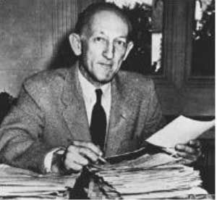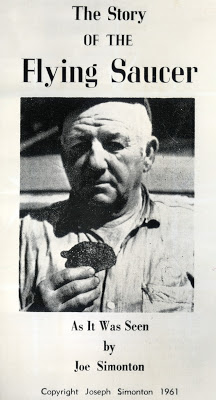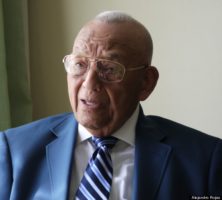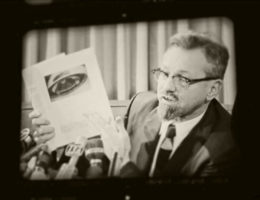by Charles Lear
 In 1961, Maj. Donald E. Keyhoe, USMC (Ret.) was the director of the National Investigations Committee on Aerial Phenomena. That year, he and his organization were making life difficult for the Air Force with criticism of their UFO investigation, Project Blue Book. This was nothing new, but now they were close to getting open hearings in Congress to address their criticisms.
In 1961, Maj. Donald E. Keyhoe, USMC (Ret.) was the director of the National Investigations Committee on Aerial Phenomena. That year, he and his organization were making life difficult for the Air Force with criticism of their UFO investigation, Project Blue Book. This was nothing new, but now they were close to getting open hearings in Congress to address their criticisms.
Then, on April 18, 1961, Joe Simonton, a 54 year-old plumber, handyman and part-time chicken farmer, reported a UFO encounter involving humanoids and offered physical evidence not usually associated with extraterrestrials. This was a strange case with a single witness, but Blue Book Director Robert Friend thought the Air Force should get involved. He mistakenly thought that NICAP would turn the case into a big story and accuse the Air Force of shirking its duties.
Simonton first told his story to his friend, Vilas County Judge Franklin Carter. Carter had been a UFO enthusiast since Kenneth Arnold’s 1947 report. Carter interviewed Simonton and wrote an exclusive report for Gray Barker’s publication, the Saucerian Bulletin.

According to Simonton, at 11:00 a.m. he heard a loud noise over his farmhouse in Eagle River, Wisconsin. He described it as sounding “something like the screech of automobile wheels as a car goes around a sharp bend fast.” He looked out a window and saw a “shiny metal” object descend and land in his driveway. It was shaped “like two plates or bowls, one inverted over the top of the other.” He went outside and a door opened in the object. A five-foot humanoid appeared in the doorway and, as Simonton approached, the “man” tilted his head back and made drinking motions.
He handed Simonton a metal vessel with two handles and Simonton said, “Oh, water.” Simonton went into his house, filled the vessel and then returned. He handed the vessel up and the “man” touched his forehead with the tips of his fingers and then pulled them away. Simonton took this to be a gesture of gratitude and he gave a military salute in acknowledgement.
During this exchange, he noticed two more occupants. All three were wearing what Simonton described as “a one-piece tunic, with no buttons or zippers that I could see, but with a hood up over the head.” The clothing was made from “what looked like a black Jersey material.” They all looked human but were smaller. Simonton described them as being “swarthy, like Italians.”
The two other occupants seemed to be tethered, one to a control panel he was working with, and the other to what seemed to be a stove with no visible flame. The one at the stove appeared to be cooking and this attracted Simonton’s interest. The occupant with the vessel noted this and picked up what looked like four pancakes and gave them to Simonton. He then shut the door and Simonton could barely see a trace of where it had been. As he was describing all this to Carter, it dawned on him that the object had been hovering during the entire encounter.
After the door closed, the craft rose up, tilted and then shot off. There was a “backwash” that caused a pine tree with an 8-9 inch trunk to bend completely back. The tree sprung forward, wobbled and then stayed upright with no noticeable damage.
Carter asked Simonton if he had the “cakes” with him. Simonton then pulled a rolled up package out of his pocket. He unrolled it and took out three of the four pieces of foodstuff that had been handed to him. He had eaten one while it was still hot and reported it tasted like cardboard. Carter described them as “oblong, about 3½” by 2½”, fairly thick, but perforated clear through with round holes about the circumference of a lead pencil.” He noted that they smelled like goose grease and were flexible like rubber.
Carter was a NICAP member, ran a UFO club and held meetings at his home. He asked if he could have one of the “cakes” for analysis and Simonton gave him one. Carter sent a piece of it directly to Donald Keyhoe along with a letter. The story made the local paper, was picked up by the news wires, and went national. Carter told reporters that Keyhoe and NICAP were analyzing a “pancake from outer space” without any confirmation from NICAP that they were willing to do so. Not wanting to be associated with the story, Keyhoe told reporters that he had returned the material without analyzing it.
According to Carter in his story for Saucerian Bulletin, he never received the material from Keyhoe nor any acknowledgement that they’d received it from him. He wrote another letter to Keyhoe and it was answered by NICAP Secretary Richard Hall. Hall explained that NICAP was “engaged in very important liaison work with Congress” and they did “not propose to compromise this work for the sake of an unproven, and, you must admit, fantastic sounding claim.” Adding to the insult, the material was still not returned.
Carter responded with an angry letter to Keyhoe telling him he should change the name of his organization from Nation Investigations Committee on Aerial Phenomena to National Suppression of Aerial Phenomena. Carter had accused Keyhoe of doing what he’d been accusing the Air Force of doing.
Keyhoe was personally criticized by other UFO investigators. An article on the last page of the July-Aug. 1961 NICAP publication, U.F.O. Investigator, responds. Titled, “Facts Behind the ‘Pancake’ Story,” it justifies NICAP’s handling of the material sent to them by Carter and points out that Carter had spoken to the press without consulting them. It then tells the story of the material’s journey into the hands of Civilian Saucer Intelligence of New York member Lex Mebane, who was then a NICAP advisor as well.
The “cake” was sent to NICAP Board Member Prof. C. A. Maney who was planning to give it to his colleague, chemistry professor Nathan Meltz. Meltz fell ill and died and it was sent back to NICAP. NICAP then sent it to Mebane, who was a chemist himself, and he did a preliminary test to identify the fat content. He identified it as hydrogenated oil. He wanted to do a chromatographic analysis that would cost $100, and an isotopic examination that would cost $180. It is explained in the article that, due to NICAP’s financial difficulties, “we do not feel justified now in spending $300 on additional pancake analyses, when more urgent projects require funds.”
 Robert Friend heard about the case on April 26 from the Duluth, Minnesota Air Defense Sector. He then spoke with Carter, who told him that he’d sent material to Keyhoe and NICAP. Friend called scientific consultant, J. Allen Hynek, at around 10:45 a.m., and said he thought “it would be advisable” to learn more about the case before NICAP turned it into a big story. Hynek agreed to fly out immediately. He took along two Northwestern University graduate astronomy students, Walter Weller and John Tumlin.
Robert Friend heard about the case on April 26 from the Duluth, Minnesota Air Defense Sector. He then spoke with Carter, who told him that he’d sent material to Keyhoe and NICAP. Friend called scientific consultant, J. Allen Hynek, at around 10:45 a.m., and said he thought “it would be advisable” to learn more about the case before NICAP turned it into a big story. Hynek agreed to fly out immediately. He took along two Northwestern University graduate astronomy students, Walter Weller and John Tumlin.
They located Simonton and interviewed him at his farm. He repeated his story and it was consistent with what had been published in the various accounts. They went to dinner and Hynek “attempted to draw him out on various topics.” Hynek noted that people passing by the table would greet him “as though he were a very respected member of the community.” Hynek went to the bar and started a conversation. It was his impression from this and other talk he’d heard around town, that most of the people in Eagle River believed Simonton.
Hynek’s biggest problem with the case was that it involved a single witness. He advised that the Air Force should hold to the practice of not investigating such cases, and that this should be noted when discussing this case. He added that the Air Force should state that this particular case was only investigated “because of its possible nuisance value.”
 Simonton gave Hynek a sample of one of the “pancakes.” It was sent to the Food and Drug Administration where a microscopic analysis showed the presence of fat, starch, buckwheat hulls, wheat bran and soybean hulls. They concluded that it appeared to be a piece of an ordinary buckwheat pancake. In regard to Simonton’s sighting, the conclusion on the Project Blue Book Record Card is “Hallucination.”
Simonton gave Hynek a sample of one of the “pancakes.” It was sent to the Food and Drug Administration where a microscopic analysis showed the presence of fat, starch, buckwheat hulls, wheat bran and soybean hulls. They concluded that it appeared to be a piece of an ordinary buckwheat pancake. In regard to Simonton’s sighting, the conclusion on the Project Blue Book Record Card is “Hallucination.”
This case proved disastrous for NICAP. They were experiencing serious financial difficulties and now they were facing harsh criticism from their peers. They were being distracted just when they were close to success with Congress. Richard Hall wrote in a letter to Mebane, “Accordingly, this “contactee” case couldn’t have happened at a worse time.” Those in Project Blue Book might have called it “karma.”
Extensive research material is available at cufos.org in the Eagle River, Wi 1961 section of Classic UFO Cases. Saucerian Bulletin can be found there in the Saucerian by Barker section of Early UFO Periodicals.